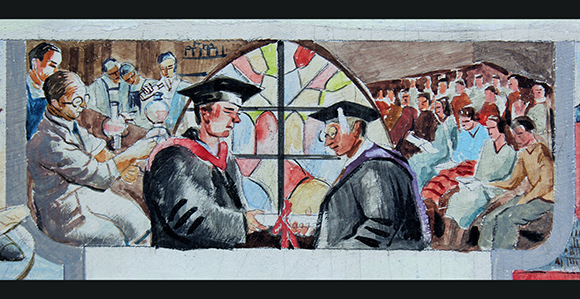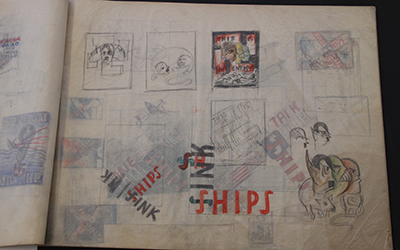Church Acquires Art of Unsung LDS Artist Joseph Paul Vorst
Contributed By R. Scott Lloyd, Church News staff writer

Detail from the mural study created by Joseph Paul Vorst for a government building in Washington, D.C.
Article Highlights
- Joseph Paul Vorst was born in Germany in 1897 and baptized in 1924.
- Among his many achievements, he created works for public buildings and posters to spread patriotism for the U.S. government during WWII.
“He had enormous success in his day. For whatever reason, the Church was relatively unaware of him.” —Glen Nelson, director of the Mormon Artists Group
Seventy-five years ago this June, through the pages of the Church’s Improvement Era magazine, Church members were introduced to Joseph Paul Vorst, described therein as “one of the finest of all Midwestern portrayers of the American scene.”
A German-American convert who has been largely unheard of in the Church since his death in 1947, Brother Vorst is coming to the fore again thanks to the acquisition last November by the Church History Department of a major portion of his works from his estate in St. Louis, Missouri.
Though not nearly as well known as other Latter-day Saint artists of yesteryear, such as Minerva Teichert, LeConte Stewart, or John Hafen, Brother Vorst is important because he “widens the discussion regarding Mormon art and the definition of who is included in the canon of Mormon artists,” said Laura Allred Hurtado, global acquisitions art curator with the Church History Department.
“This widening is not only within the context of the United States, but also includes Europe,” she said.
“He had enormous success in his day,” added Glen Nelson, director of the Mormon Artists Group based in New York City. “For whatever reason, the Church was relatively unaware of him.”
Born in Essen, Germany, in 1897, he found the Church in his homeland, where he was baptized in 1924.
.jpg)
World War II era work created by Joseph Paul Vorst is typical of the patriotic posters he created for the U.S. government to rally the spirit of the American people. Photo courtesy of the Church History Library.
.jpg)
A frame of Joseph Paul Vorst’s mural study for a federal government building was part of a recent acquisition by the Church of some of the work of the artist and Latter-day Saint. Photo courtesy of the Church History Library.
.jpg)
Painting by Joseph Paul Vorst is part of a recent acquisition by the Church of some of the work of this German-American artist and Latter-day Saint from the World War II era. Photo courtesy of the Church History Library.
.jpg)
Joseph Paul Vorst created the mural study pictured above for a government building in Washington, D.C., in 1942–43 as part of the government’s Works Project Administration. Photo courtesy of the Church History Library.
.jpg)
An untitled portrait of a farmer created in 1940 by Joseph Paul Vorst is characteristic of the Regionalism movement that Vorst and other Midwestern artists were part of. Photo courtesy of the Church History Library.
.jpg)
Some of the work of Joseph Paul Vorst seems to contain hints of his Latter-day Saint beliefs, such as this sketch for a work that seems to suggest Joseph Smith’s First Vision. Photo courtesy of the Church History Library.

An item from the sketchbook of Joseph Paul Vorst shows his development of a concept for a World War II era patriotic poster conveying the slogan common at the time, “Loose Lips Sink Ships.” Photo courtesy of the Church History Library.
He had been part of the leading impressionist movement in Germany before coming to the United States in 1935 and establishing himself in St. Louis, Missouri. According to the Improvement Era article, he came “to obtain unreserved liberty for himself and his talents,” and he chose Missouri because of its association in Latter-day Saint belief with Adam-ondi-Ahman, the place where Adam and Eve dwelt after they left the Garden of Eden.
The article identified him as art director at Jefferson College in St. Louis and a member of the St. Louis Branch of the Church. “A constant missionary himself among his friends, his introductions assist the full-time missionaries in their activities,” wrote the author, William Mulder.
In the United States, he became part of the art movement in the 1930s known as Regionalism. Its practitioners, reacting against city life and rapidly developing technology, focused on rural scenes. The movement is characterized by the works of Midwesterners Grant Wood, John Steuart Curry, and Thomas Hart Benton, Brother Vorst’s close friend and fellow Missourian.
“He came to Utah and exhibited at the Deseret Gym art room in Salt Lake City and the Springville Art Museum,” said Brother Nelson, who assisted Sister Hurtado in securing the acquisition from Brother Vorst’s estate.
He was introduced to the Salt Lake public by prominent Utah artist and state legislator Alice Merrill Horne. “But he had all of his success elsewhere, really,” Brother Nelson said. “He showed at the Metropolitan Museum of Art, the Whitney Museum, the Art Institute of Chicago, the Corporate Gallery, the San Francisco Museum, the Carnegie Institute, the Library of Congress, the World’s Fair, even at the White House. … Credentials like that are almost unheard of in Mormon art.”
Brother Vorst became a United States citizen and traveled widely. As part of the Federal Art Project under the U.S. government’s Works Project Administration, he created works for public buildings and posters to help spread patriotism during World War II, a significant thing for a German World War I veteran whose service had left him permanently lame in one leg.
“So he has just an extraordinary range, which is so very unusual in Mormon art,” Sister Hurtado said. “And in all of that, he puts Mormon clues into the works.
“For instance, when Glen and I were in St. Louis in November, we saw a mural study of his hanging in a gallery there, a study of Americana. It was for a commission that he ultimately didn’t get. But in the far left corner, you see the Salt Lake Temple there hidden. No one in St. Louis had picked that up: not his family, not the galleries.”
Part of the Church’s acquisition is a lithograph showing a picture of a young boy. The title is “Joe and His Mission.” At first glance, one would think it to depict any typical farmboy.
“But we know who ‘Joe’ is and what his ‘mission’ was,” Sister Hurtado said, alluding to the Prophet Joseph Smith.
Though his works were not overtly LDS in content, “what they really had in them was a deep Christian spirit regarding charity,” Brother Nelson commented. “He lived in a time, both of the Great Depression and of turmoil in the South regarding enormous flooding, sharecropper troubles, politics, and finance. His choice was to depict people in a very ennobling way. Mormon historical pieces tend to depict the pioneer experience with a lot of detail, but his depictions are of the downtrodden and the dispossessed in the 20th century.
“So even though these works aren’t overtly LDS, I think they’re prototypically Mormon in their sensibility and content.”
One of the Vorst works from his Germany period is a book titled Der Vulkan, German for The Volcano. The book is a compilation of linoleum cuts, a form of printing technique similar to woodcuts in which a sheet of linoleum is used for the relief surface.
“It has a sort of story with a text and these images, so incredibly beautiful,” Brother Nelson said in describing the book. “And the final image is a picture of the Savior that is just a knockout. So he found a way to bring his new religious beliefs into the fine art world of Germany. In this way he is a template for Mormon artists, how they can bring these two worlds together, their fine art and their deeply held religious beliefs—basically the head and the heart.”
The Vorst acquisition came about after Sister Hurtado saw an Internet blog post about the artist written by Brother Nelson, who had earlier become aware of him through the work of another LDS blogger, Ardis E. Parshal.
The Vorst family also had seen Brother Nelson’s blog post and reached out to him. Together, he and Sister Hurtado arranged with the family for the acquisition.
Though not members of the Church, “they were extremely generous to us,” Sister Hurtado said. “I think embedded in that is their desire to preserve their father’s legacy, and I think they have a real respect for their father’s faith. They themselves are Christians. They run a school in Haiti and do a lot of philanthropic work.”
The items in the acquisition are undergoing conservation now at the Church History Library, and the works will be exhibited at the Church History Museum after it reopens following its current yearlong renovation, Sister Hurtado said.
